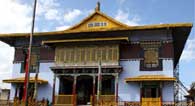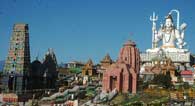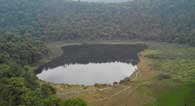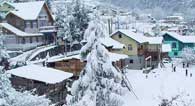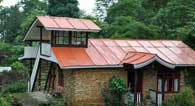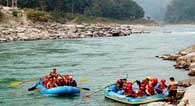CONTACT US
Church Road, Near Pelling Taxi stand, Gangtok-737101, Sikkim, India
Phone no.
+91-9832564013, 03592-206888, 9002069916, 9933448360.
Email : sikkim444@gmail.com
Trekking in Sikkim
Sikkim a tiny state of India with an area of 7096sq.km. situated in the eastern Himalaya boast of its rich bio-diversity and high
mountain ranges. Kanchendzonga the third highest peak in the world is also the guardian deity of Sikkimese people.
Variation in altitude range in 200 to 8598meters (height of Kanchendzonga) which provides an opportunity to any visitors to have an
experience of crossing over sub-tropical to temperate zones followed by alpine and high altitude areas in a short span of time. 4000
species of flowering plants, 600 species of birds, 560 species of Orchids, 40 species of Rhodendrons and large number of other animals
are sheltered in this tiny state. Numerous snow-clad peaks, alpine lakes and swirling clouds beautify the area for any adventure
lovers.
Trekking in Sikkim has its own charm. Trail runs through rich biodiversity and rich cultural life of Sikkimese people. There are
numerous trails, which leads to high mountain areas as close as Kanchendzonga. Goechala Trek, Singalila Trek, Rhodendron Trek,
Monastic Trek, Village Trek and Green Lake trek can be opted by any individual for the pleasure of seeing the mountain. Yuksom
situated in the remote and far flung area of Sikkim is the gateway to Kanchendzonga Trekking, the trail widely used by trekkers
from all over the world. In the 1640 AD, three monks who came from different parts of Tibet consecrated first King of
Sikkim on throne.
Unlike in Nepal, trekking areas in Sikkim are mostly barren and are located in the Kanchendzonga National Park. Preparation
of trekking programme mostly begins at Gangtok with lots of planning and logistics support. Proper equipments, such as good high
altitude tents and sleeping bags, which can withstand the high wind velocity and freezing temperature, is a must. Beside these most
important equipments trekkers need to have good trekking shoes, down feather jacket, caps, gloves and in some cases gaiters to get
away from heavy snow on the way.
As we trek higher and higher oxygen content in thin air is lesser and lesser. This invites one to get high altitude sickness.
Acclimatization is needed between 2500 to 3000 meters, which allows ones red blood cells to increase to negotiate the rough trail
ahead. High Altitude Sickness can cause death if it is not prevented in time. There is no remedy to tackle this sickness but the
preventive measure can help one get going without any disturbances. There are many symptoms, which can be easily noticed in ones
behavior. Nausea, vomiting, diarrhea, dysentery, dehydration, headache, sleeplessness, decrease of appetite, breathlessness,
heaviness and one feel weak to carry forward. Tenzing Norgay Sherpa the first Everester always emphasized on acclimatizing in the
mountain. He said, ?after every climb, rest?.
Altitude sickness can be prevented through numerous measures. Slow and gradual ascend, good intake of mostly hot water, soup
with strong garlic, corn and other staple food rich in carbohydrates. The food contents should be in varieties, which provides
vitamins. Acclimatizing between 2500 to 3000 meters and later at 4000 meters is a must to prevent sickness if one is trekking
up to 5000 meters. Trekking above 5000 meters require acclimatizon in much more with may be two days of rest.
Trekking trails runs through dense forest with an undulating climbs and some time it is very sharp. Some time trekkers require to
tread on soft snow. 3500 meters above trails begins to run through Rhodendron and Juniper bushes with ample opportunity to view snow
clad peaks. Mountain lures, excitement over power senses and the chances of mishap is higher.
Trekking is an adventure activities, which has lots of risks. Trekking trails cross over mountain passes, which are sometime steep
and some time slippery. Vagaries of weather suddenly forces entire programme to abandon. Snow blizzard, snowstorm in the high altitude
areas injects the snow blindness and the visibility becomes zero and incessant rains in the lower areas prevent the completion of
trekking. There is very high chance of getting equipment and food stock wet. High velocity wind some time adds to the loss of tents
and other equipments. Tents are blown away, mast is broken and the chances of heavy snow burring human and the tent is at higher risk.
Snow blizzard and snowstorm covers the trail with thick snow and some time trekkers are trapped. In such situation, guide plays a
vital role and takes the responsibility to safely evacuate the team.
Trekking is a teamwork and not an individual event for any strong man. Guide, cook, porters, yaks and the trekkers looking for
good and adventurous holiday has different role to play. In most cases, guide plays a vital role of taking the responsibility of
organizing al most everything right from the start of the trek. His supervision and proper decision in situation is a must. He
requires co-operation and coordination from porters, cooks and yak man to negotiate inclement weather.
Cook has to prepare food as per the needs and altitudinal variation and he must also measure the requirements. He is responsible for
taking care of the stock. There should not be shortage of food and hygiene should not be compromised. Good cook begins to decrease
the use of oily ingredients, salt as the altitude begins to rise, but would improve upon using more of garlic and carbohydrates.
This will help in prevention of sickness.
There are numerous routes for trekking in Sikkim, which are at the best during spring and autumn. Spring provides clear Mountain
View with varieties of flowering plants in blossom. On the other hand, autumn provides a dry and clear mountain views. There are
many trekking trails in Sikkim, which can be classified.
During the trekking season, Dzongri Area is like little Europe. Thousands of foreigners use the trail to reach the highest point?
The Goechala? situated at 4940meters. Beside these many trekkers taking up the trail, still the negative impact on the environment
is negligible.
Most of the mountain areas in Sikkim have a fragile ecosystem. This demands any trekkers to obtain special permit to trek.
Trekking in Sikkim is conducted in an organised manner. Individual cannot trek on their own. Travel Agents? Agents Association of
Sikkim has created its own environmental code of conduct. Campfires are not permitted but camp fun can be organised. As the trekking
season comes to an end various NGOs and government agencies work in unison to clear up the trails.
Most of the staff in the trekking agencies is well trained to cope with the situation and they also help in policing the protected
plants and animals. Chances of bio-piracy is al most nil in Sikkim. Trekking team generally brief the clients about the dos and
don'ts while trekking in Sikkim.
Sikkim the land of peace and tranquility is an ideal destination for trekking. People living in hustle and bustle of city life,
people with financial or mental stress can rejuvenate themselves while trekking. Higher in the mountain, silence prevail but with
sound of bird chirp. Night sky is clear with constellation at a full glow. Silent ambience takes away all the grief.





